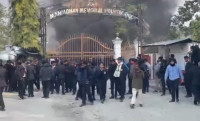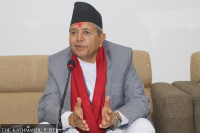National
Bhattarai, Yadav agree to merge their parties to form Samajbadi Party Nepal
Two years after a failed attempt, Baburam Bhattarai and Upendra Yadav have finally found a common ground and decided to merge their parties—Naya Shakti Party-Nepal and Sanghiya Samajbadi Forum-Nepal—to create a new force, Samajbadi Party Nepal.
Chandan Kumar Mandal
Two years after a failed attempt, Baburam Bhattarai and Upendra Yadav have finally found a common ground and decided to merge their parties—Naya Shakti Party-Nepal and Sanghiya Samajbadi Forum-Nepal—to create a new force, Samajbadi Party Nepal.
The two parties in recent days had expedited talks to merge their parties, and on Thursday, Bhattarai and Yadav held a meeting, also joined by the Rastriya Janata Party-Nepal and Janamukti Party, which according to leaders, set the tone for the unification of the two parties.
“The Samajbadi Party Nepal will work to institutionalise federal democratic republic while striving for ending all forms of discrimination, exploitation and inequality based on caste, class, gender and region, which are prevalent in Nepal,” reads a press release signed by Bhattarai and Yadav.
Leaders said the merger was necessitated by an apparent lack of a “strong third force” and that the unified Samajabadi Party Nepal will strive for creating an “alternative force” in the country.
A formal announcement of the new party has been scheduled for Monday, according to Rajendra Shrestha, co-chair of the Sanghiya Samajbadi Forum-Nepal. The ideology and guiding principles of the party are expected to be made public the same day.
“This is not only an event that brings the two parties to make them one,” said Dambar Khatiwada, a spokesperson for Naya Shakti. “It’s the beginning of our larger goal to develop a third alternative force in the country. It’s a quest for creating a strong third force after the Nepal Communist Party and Nepali Congress.”
As per an agreement reached between the two parties on Saturday, both Bhattarai and Yadav will lead the party as chairpersons. Bhattarai will lead the party’s “federal council” and Yadav will helm the central committee. The new party will have 25 office bearers—16 from Forum and 9 from Naya Shakti.
Bhattarai, however, will maintain the senior position in the party, according to leaders.
“Since the federal council is above the central committee, Bhattarai will hold the ‘number one’ position in party hierarchy followed by Yadav,” Shrestha told the Post. “We will have two chairpersons, but our’s is not like ‘erroneous’ system the ruling Nepal Communist Party is following. In the Nepal Communist Party, both KP Sharma Oli and Pushpa Kamal Dahal are chairpersons of the central committee. But in our party, Bhattarai will lead the federal council, while Yadav will lead the central committee.”
The new party, according to leaders, will have around 1000-strong federal council and its central committee will have 380 members.
But given the backgrounds of the two parties—or the two leaders for that matter—one carries the legacy of the “people’s war” while another rode on identity politics to rise in the national political spectrum, it is not clear what kind of ideology and guiding principles the new Samajabadi Party Nepal is going to adopt.
Bhattarai, one of the key architects of the “people's war” which claimed 17,000 lives, left the Maoist party in 2015, days after the promulgation of the constitution. He also led the Maoist government from 2011 to 2013.
While quitting the Maoist party, Bhattarai though had told reporters he did not have any immediate clear plan, he had dropped a hint of establishing a new force by joining hands with the like-minded people.
In June 2016, Bhattarai launched his own party—Naya Shakti Nepal—amid a grand function in the Capital. But his new outfit struggled to gain traction.
In October 2017, Bhattarai appeared alongside Oli and Dahal at a programme to announce the formation of a grand left alliance of then CPN-UML and CPN (Maoist Centre).
Bhattarai, however, pulled out and stopped short of becoming part of the alliance after differences over the name of the new party—he did not want the party name to have a 'communist' label—and division of electoral constituencies.
Bhattarai while maintained the stature of a political leader, his party continued to grope in the dark.
In the 2017 elections, Bhattarai’s party fared badly. He is the sole representative of Naya Shakti Party-Nepal in the federal parliament, as he won the election from Gorkha riding on his own popularity rather than his party.
Yadav, on the other hand, has seen a steady rise in Nepali politics since the 2007 Madhes movement. His Sanghiya Samajbadi Forum-Nepal with 16 seats in the federal parliament is the fourth largest party.
Yadav's party, however, is currently supporting the incumbent government and he is the deputy prime minister and health minister in the Oli Cabinet.
Yadav's Sanghiya Samajbadi Forum-Nepal is also running a coalition government with the Rastriya Janata Party-Nepal in Province 2.
Though Bhattarai and Yadav have decided to join hands on Saturday, both were on the same page in the aftermath of the constitution promulgation at least on one agenda: that the constitution was discriminatory.
In the days leading up to the constitution promulgation, Yadav, along with other Madhesi, Janajatai and Tharu leaders, was spearheading protests along the plains, saying the constitution-drafting process was flawed and that provisions of the draft marginalised some sections of the society.
Nonetheless, the constitution was promulgated on September 20, 2015, despite objections from the Madhesis, Tharus and Janajatis.
Bhattarai also expressed his dissatisfaction at the constitution, saying the Madhesi voices were ignored.
Yadav’s Samajbadi Forum’s demand for constitution amendment is still alive, even though it has hardly pressed the government for the same, which many say because of the fact that it is part of the government.
Tula Narayan Shah, a political analyst, said the merger of these two parties was long in the pipeline.
“The new party has brought three strong leaders—Bhattarai, Yadav and Ashok Rai—together,” Shah told the Post. “They have their own personalities and presence in the national politics. Together they can fill the void of a real and strong ‘alternative force’ in the country.”
Despite some skepticism, political observers said the trio can make a good combination and lead the party well if the three leaders who come from different communities strike a fine balance.
“There has been the realisation that despite several movements in Madhes until 2015, some major achievements are still pending,” said Shah. “Every time Madhes movement was perceived as an event that polarised Pahad and Madhes communities. The new party, which brings together marginalised communities like Madhesi and Janjati and someone like Bhattarai, who hails from dominant Khas Arya community but speaks for rights of the Madhesi and other marginalised communities, can be really helpful in creating a whole new movement.”
Leaders are learnt to have been also in talks to bring other like-minded forces to the newly formed Samajbadi Party Nepal.
“We will continue dialogue with like-minded forces for unification even after the merger of Naya Shakti and Samajbadi Forum; maybe we can work with them by forming a working alliance for now,” said Ganga Shrestha of Naya Shakti Party-Nepal, who headed a talks panel formed to take the merger process forward.
Tika R Pradhan contributed reporting




 13.12°C Kathmandu
13.12°C Kathmandu















